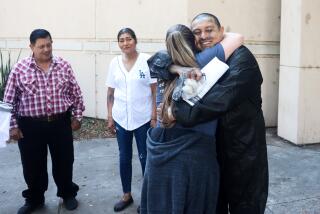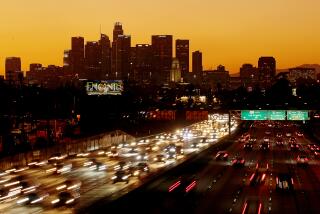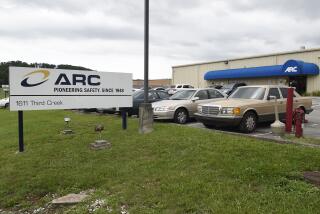Car Booster Seats Defective, Parents Allege in Recall Bid
- Share via
WASHINGTON — The parents of 3-year-old Patricia Fairfax and those of Christopher Armstrong, 2, thought they were keeping their car-bound children safe. They put them in booster seats that used padded plastic barriers across the chest instead of straps to hold toddlers in place.
But Patricia and Christopher were killed in separate crashes while younger siblings, riding in car seats with built-in straps, survived.
For the record:
12:00 a.m. Oct. 16, 2002 For The Record
Los Angeles Times Wednesday October 16, 2002 Home Edition Main News Part A Page 2 ..CF: Y 6 inches; 222 words Type of Material: Correction
Child seats -- An article on Sept. 24 in Section A mistakenly reported that Canadian safety officials prohibited auto booster seats for children under 40 pounds as a result of crash tests. In fact, the prohibition was instituted before the crash tests were conducted.
Today, a group of parents and their lawyers will petition Canada-based Dorel Industries to voluntarily recall as many as 10 million of the booster seats. In a letter to Dorel Chief Executive Martin Schwartz, the parents contend that the seat is defective because it “has no harness restraint to retain the upper torso.”
Dorel’s Cosco unit is the only company still manufacturing the “shield boosters,” which hark back to early child-seat designs. Cosco says tests by the U.S. government and by experts hired by the company validate the seats.
“This product is a safe product that is saving children’s lives,” said Ken Mitchell, a company spokesman.
Although many safety advocates and the American Academy of Pediatrics recommend that parents not use shield boosters, the seats continue to be sold because they meet minimum federal safety standards.
Priced as low as $20, they are also a bargain.
Children have allegedly been injured in two ways: by being ejected during rollovers and by breaking their necks or injuring their heads as they are thrown forward, doubled over, in severe head-on collisions.
Trial lawyers have compiled records of at least 18 deaths blamed on Cosco shield boosters from 1987 through 2001. The company sold a seat called the Explorer starting in 1985 and replaced it with the Grand Explorer in 1996.
The government’s auto safety agency--the National Highway Traffic Safety Administration--has received reports of six deaths and eight injuries in 14 crashes. “It’s being closely monitored,” said spokesman Rae Tyson.
Federal regulators should do more than monitor the situation, said Ann Brown, who chaired the federal Consumer Product Safety Commission from 1994 to 2001. “I would label this shield booster a booby trap for babies,” said Brown. “You obviously have a problem here, and you don’t need a bunch of dead babies to pile up before you take action.”
The auto safety agency has been criticized for sending mixed messages about the seats.
In a safety brochure issued during the Clinton administration, the agency pictured a child in a shield booster with an emphatic, bold “NO!” But in its latest consumer advice, it does not take a stand and merely reports the recommendation of the pediatrics group.
“I want to get the word out for parents to stay away from those car seats because they’re unsafe,” said Patricia’s father, Alfred Fairfax of Fayetteville, N.C.
After his 1996 crash, Fairfax said his neighbors got rid of shield boosters they had bought for their own children. “They absolutely took them out of their cars and threw them away,” he said. The Easter Sunday wreck was caused by another driver, who apparently fell asleep and hit Fairfax’s 1994 Chevrolet Cavalier head-on.
Patricia was in the center of the back seat, the position regarded by experts as the safest for a child, her father said. She died of a broken neck.
Sitting to Patricia’s right was sister Heather, 2 at the time. Buckled into a car seat with shoulder straps, she suffered only a broken leg.
In 1998, Cosco settled a lawsuit brought by the Fairfax family. The company paid a confidential sum without acknowledging liability.
A nurse from Victoria, Texas, says her experience belies Cosco’s claims that its seats are safe. Melanie Armstrong’s son, Christopher, died after being ejected from the family’s Plymouth Voyager in a 1999 rollover. The minivan went off the edge of the road on a curve, and Armstrong said she panicked and over-corrected, losing control.
Christopher was riding in a Cosco Explorer booster, which his mother had strapped into the third-row bench seat of the minivan. Armstrong remembers pressing with her knee on the booster seat to make sure the lap belt holding it in was as snug as possible.
“Christopher was thrown from the van,” said his mother. “My two other sons were also with me, and they were fine.”
Joseph and Jacob were riding in the minivan’s second row of seats. Four-year-old Jacob, in an adult lap and shoulder belt, had a bump on his head, said his mother. Joseph, 15 months old, in a child seat with shoulder straps, “had no injury whatsoever,” she said.
“The only person I can blame for the accident is myself,” said Armstrong. The family filed a lawsuit against Cosco, which the company settled. Armstrong went on to found Parents Against Cosco Explorers, the group that is petitioning the company for a recall.
“I still see the seats,” said Armstrong. “Any time I’m in Wal-Mart and I see people looking at them, I tell them not to buy them.”
That Christopher Armstrong and Patricia Fairfax died while their siblings survived was not the consequence of their riding in Cosco seats, said a company representative.
“Every occupant of a vehicle in a crash actually experiences a different incident,” said Jonathan Reynolds, Cosco’s general counsel. “They have different forces acting in different ways ... because of their position in the vehicle.”
But the Armstrongs’ lawyer said the crash amounted to a real-world test. “One child is ejected and the others are unharmed--I don’t know how much more you have to have before the government does something,” said Brantley White.
In a 1995 report using child-sized dummies, a Canadian safety agency documented seven cases of ejection in 10 tests of shield boosters. Three tests involved the Cosco Explorer, and the dummies were totally or partly ejected in two of them.
Because of the tests, Canada does not allow children under 40 pounds--or roughly under 4 years of age--to be placed in shield boosters.
Christopher Armstrong weighed about 35 pounds, his mother said.
In the United States, federal rules allow shield boosters to be used only for children who weigh between 30 and 40 pounds. For older children, the shield should be removed and the base of the seat used to position the child in the car’s lap and shoulder belts.
U.S. safety tests for child seats simulate a head-on crash, not a rollover.
Cosco attorney Reynolds said the rollover testing by Canadian authorities “was not properly documented in several respects.”
Cosco has also released a letter from a Virginia consumer whose 5-year-old daughter survived a rollover crash unharmed in a Grand Explorer seat.
The American Academy of Pediatrics has sided with the Canadian position.
“Children who weigh 40 pounds or less are best protected in a seat with a full harness,” the doctors’ group said in a recommendation issued this March. “Significant injuries to the head, spine, abdomen and extremities of children in shield boosters have been documented in crash investigations. Although boosters with shields may meet current federal motor vehicle safety standards, [the academy] does not recommend their use.”
More to Read
Inside the business of entertainment
The Wide Shot brings you news, analysis and insights on everything from streaming wars to production — and what it all means for the future.
You may occasionally receive promotional content from the Los Angeles Times.










